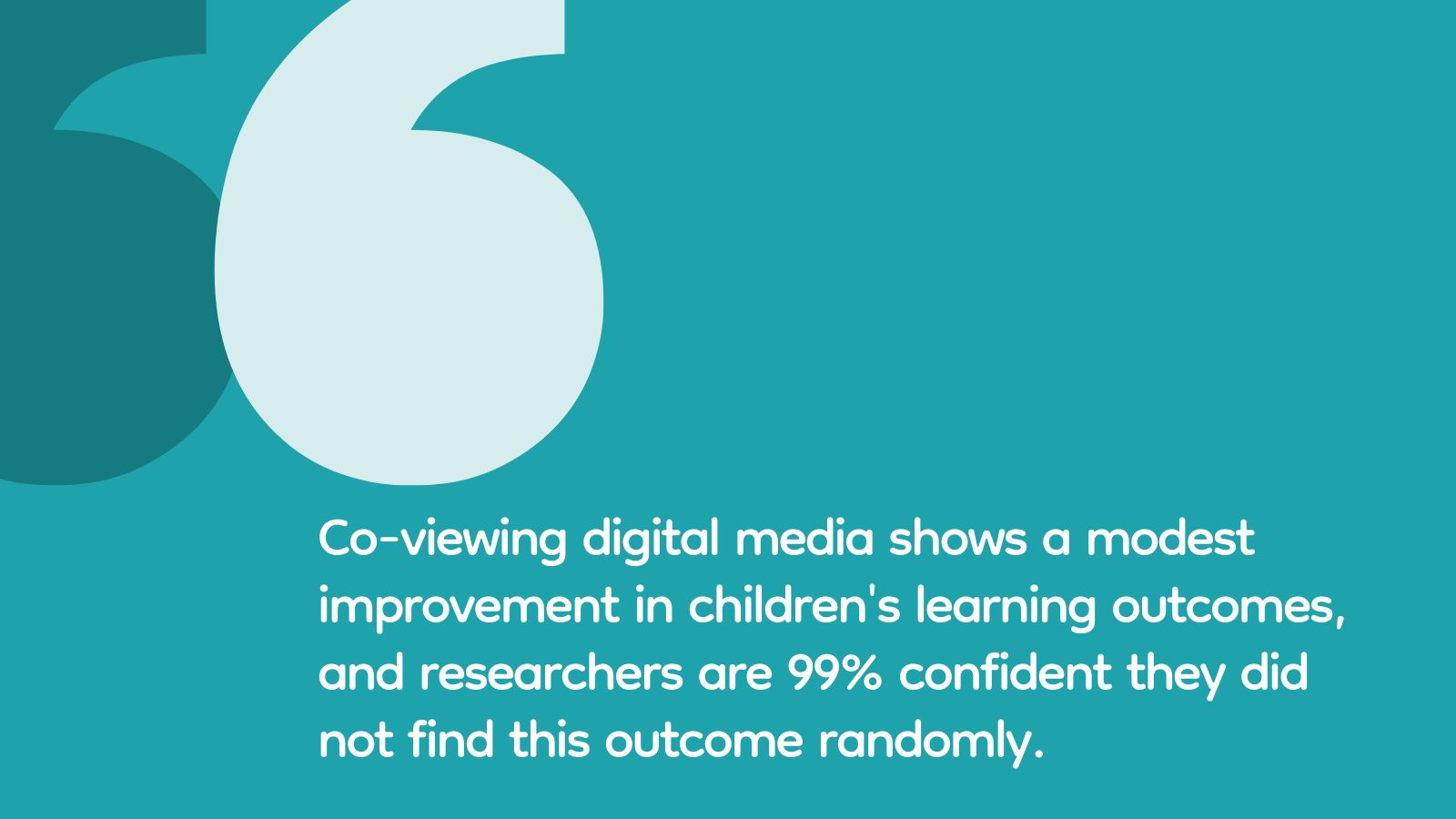As a new mom, I have all sorts of questions about early childhood education that I never had as a secondary school teacher. I often find myself wondering whether the digital content my son consumes can be more than just a pacifier in a desperate moment. I know that throughout my multiple mom groups, many are worried about the impact of screen time on young minds. But after discovering this study led by Gemma Taylor, I am soothed by their compelling evidence that engaging in digital media with young children can turn screen time into learning time.
Co-viewing digital media with children ages 0-6 can enhance their learning experiences.
Dr. Taylor’s systematic review and meta-analysis explored the effects of adult-child co-use of digital media on learning outcomes for children ages 0-6. Seventeen studies were analyzed, revealing a small but significant positive effect on learning when adults co-use digital media with children. Interested in that definition of co-use? This could include activities where both adult and child are engaged in viewing, discussing, or interacting with the digital content together. The adult could actively discuss the content with the child during or after media use. This could also look like using educational apps together or employing interactive storytelling after digital use. Let’s discuss some more of their key findings.
Key findings from Taylor et al. (2024):
- Small but significant learning benefits. Co-use of digital media shows a modest improvement (effect size of 0.20, which is not bad at all for social science!) in children’s learning outcomes, and the researchers are 99% confident they did not find this outcome randomly.
- Consistent across studies. Despite its size, the effect was consistent across various study designs and media types. Several studies support the researchers’ conclusion.
- No significant moderators. Variables such as child age or type of media did not significantly alter the effect size. So depending on the difference between Sesame Street and Super Why, if an adult was still connecting with the child during consumption of the show, it was still helpful for the child!
Can we trust this research?
Not all research holds the same value! Here’s what our We Are Teachers “Malarkey Meter” says when it comes to this publication, based on four key factors.
- Peer-reviewed? Yes! This study underwent a rigorous peer-review process and likely passed through many rounds of review, adding a layer of credibility to the findings.
- Sample size: The study analyzed data from 1,288 children across 17 selected studies. While 1,288 is ample study power, the researchers conclude that 17 studies for a meta-analysis is on the smaller side. Adding more studies to the formula might bolster the meta-analysis, but they utilized all the studies available.
- Trustworthy sources: This manuscript was published in Educational Research Review, one of the most competitive journals to publish with. Additionally, the research team (Gemma Taylor, Giovanni Sala, Joanna Kolak, Peter Gerhardstein, and Jamie Lingwood) have garnered more than 4,500 combined citations!
- Methodology: This study used a systematic review and meta-analysis to investigate their question. This basically means their study was a study on multiple studies. Meta-analyses are no easy feat, but they checked all the boxes for methodological rigor!
What does this mean for teachers?
This research provides some insights about engaging in digital media for inquisitive adults. Dr. Taylor told the We Are Teachers team, “With the rise in the use of digital media in the classroom, it is essential that teachers consider how to incorporate adult-child co-use to support children’s learning.” Here’s how teachers can apply these findings:
- Encourage active participation. Instead of passive consumption, encourage parents to engage with digital content alongside their children. I highly recommend the Cookie and Gonger “Foodie Truck” song!
- Select appropriate media. Choose educational apps and programs designed for interactive engagement. Not to be shoving PBS Kids down anyone’s throat, but the PBS Kids App is where it’s at!
- Educate parents. Inform parents about the benefits of co-using digital media, providing guidelines on how to interact effectively. Simply sitting with the child probably isn’t going to cut it—there needs to be some level of connection occurring.
Dr. Taylor and her team bring a refreshing perspective that engaging in digital media with young children doesn’t just fill a quiet moment—it enriches it. As educators and parents, we have the opportunity to transform screen time from a solo activity into a joint adventure that supports learning. Whether you’re a teacher guiding parents or a parent yourself, remember that your interaction with a child during screen time is what turns it into a valuable teaching moment. Engaging in digital media together not only helps build essential early learning skills but also enhances our connection with the little learners in our lives. So, the next time you press play on a tablet or TV, consider it an invitation to engage, educate, and inspire.


